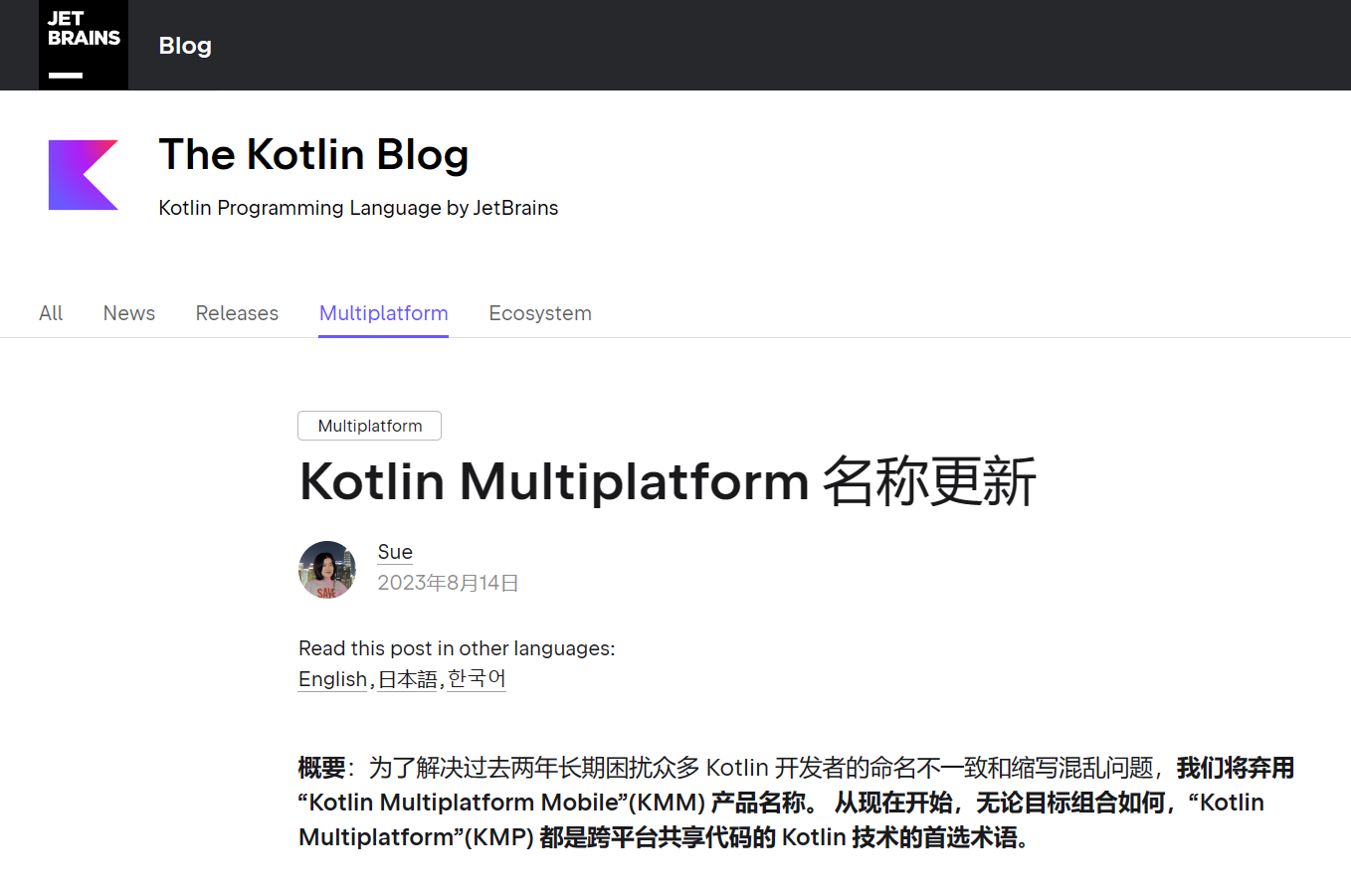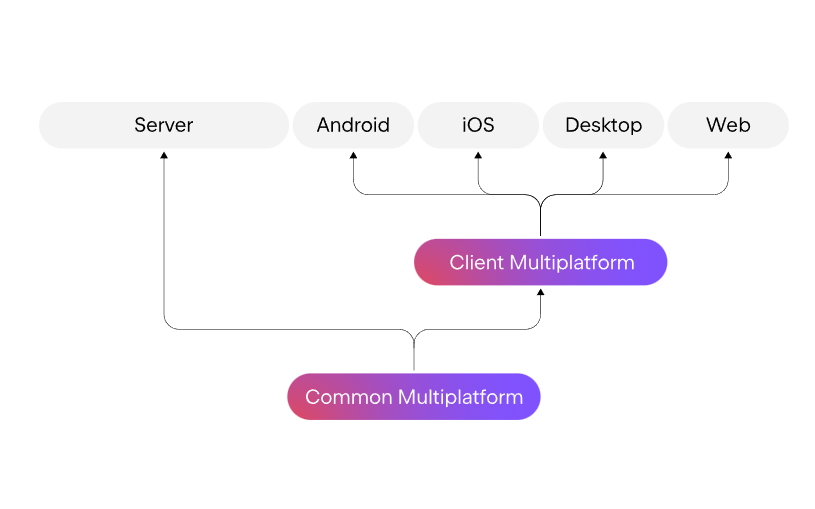 Technology peripherals
Technology peripherals
 It Industry
It Industry
 To solve the name confusion problem, Kotlin's cross-platform development technology is named KMP
To solve the name confusion problem, Kotlin's cross-platform development technology is named KMP
To solve the name confusion problem, Kotlin's cross-platform development technology is named KMP
The JetBrains official website recently announced on its blog that in order to solve the problems of inconsistent naming and confusing abbreviations that have plagued many Kotlin developers in the past two years, the official website has decided to abandon the "Kotlin Multiplatform Mobile" (KMM) product name
From now on, "Kotlin Multiplatform" (KMP) is the preferred term for Kotlin technologies that share code across platforms, regardless of the target combination.

This site learned from the blog that Kotlin Multiplatform was first released at KotlinConf 2017 under the name "Kotlin Multiplatform Projects" and initially supported JVM, Native and JS target. Early adopters mainly use the abbreviation "KMP" and less frequently "MPP" . Until 2020, the technology was in an experimental phase, with the team making adjustments based on feedback from early adopters.
In 2020, the official will shift its focus to code sharing between iOS and Android, and hopes to attract more mobile developers to use Kotlin Multiplatform. In order to reflect this focus, the official will combine iOS and Android in Kotlin Multiplatform. Everything related to code sharing between Android was split into a separate product called "Kotlin Multiplatform Mobile", the abbreviation KMM was introduced, and an Alpha version was announced. At the same time, the official also released the Kotlin Multiplatform Mobile plug-in for Android Studio.
While the alpha version of the new Kotlin Multiplatform Mobile name has attracted attention, it has also brought confusion as developers are unsure what to call the technology that shares code outside of iOS and Android. Some existing community content and libraries also have "KMP" in their names, further adding to the confusion, resulting in the ecosystem having multiple names - Kotlin Multiplatform and Kotlin Multiplatform Mobile - as well as the abbreviations KMP, KMM and MPP.

In order to solve the naming inconsistency and abbreviation confusion that has plagued many Kotlin developers in the past two years, JetBrains decided to abandon the "Kotlin Multiplatform Mobile" product name.
No matter which platform combination is used, from now on, "Kotlin Multiplatform" (KMP) is the preferred term for Kotlin technology that shares code across platforms
According to JetBrains official statement, KMP is very Suitable for sharing code on multiple platforms, not only iOS and Android, but also with desktop and server side. In addition, the official is actively developing Kotlin/Wasm, aiming to promote the use of Kotlin Multiplatform for modern Web development

Advertising statement: The external jump contained in the article Redirect links (including but not limited to hyperlinks, QR codes, passwords, etc.) are used to convey more information and save selection time. The results are for reference only. All articles on this site include this statement.
The above is the detailed content of To solve the name confusion problem, Kotlin's cross-platform development technology is named KMP. For more information, please follow other related articles on the PHP Chinese website!

Hot AI Tools

Undresser.AI Undress
AI-powered app for creating realistic nude photos

AI Clothes Remover
Online AI tool for removing clothes from photos.

Undress AI Tool
Undress images for free

Clothoff.io
AI clothes remover

Video Face Swap
Swap faces in any video effortlessly with our completely free AI face swap tool!

Hot Article

Hot Tools

Notepad++7.3.1
Easy-to-use and free code editor

SublimeText3 Chinese version
Chinese version, very easy to use

Zend Studio 13.0.1
Powerful PHP integrated development environment

Dreamweaver CS6
Visual web development tools

SublimeText3 Mac version
God-level code editing software (SublimeText3)

Hot Topics
 1664
1664
 14
14
 1422
1422
 52
52
 1316
1316
 25
25
 1267
1267
 29
29
 1239
1239
 24
24
 How to perform data verification in C++ code?
Nov 04, 2023 pm 01:37 PM
How to perform data verification in C++ code?
Nov 04, 2023 pm 01:37 PM
How to perform data verification on C++ code? Data verification is a very important part when writing C++ code. By verifying the data entered by the user, the robustness and security of the program can be enhanced. This article will introduce some common data verification methods and techniques to help readers effectively verify data in C++ code. Input data type check Before processing the data input by the user, first check whether the type of the input data meets the requirements. For example, if you need to receive integer input from the user, you need to ensure that the user input is
 Go Language GUI Development Guide: Implementing Cross-Platform Interface Design
Mar 22, 2024 pm 02:00 PM
Go Language GUI Development Guide: Implementing Cross-Platform Interface Design
Mar 22, 2024 pm 02:00 PM
As a fast and efficient programming language, Go language has been widely used in back-end development. However, with the continuous development of Go language, more and more developers are beginning to try to use Go language for GUI interface development in the front-end field. This article will introduce readers to how to use Go language for cross-platform GUI interface design, and provide specific code examples to help readers get started and apply it better. 1. Introduction to Go language GUI development GUI (GraphicalUserInterface, for graphics)
 How to install the Kotlin programming language 12 on Debian
Feb 20, 2024 am 09:42 AM
How to install the Kotlin programming language 12 on Debian
Feb 20, 2024 am 09:42 AM
Kotlin is a statically typed programming language that has attracted huge attention in the field of software development. Its concise and easy-to-understand syntax, good compatibility with Java, and rich tool support provide developers with many advantages, so many developers choose Kotlin as their preferred language. Install Kotlin Programming Language 12Bookworm on Debian Step 1. Start by updating existing system packages. Open a terminal and enter the following commands: sudoaptupdatesudoaptupgrade These commands will get a list of available updates and upgrade current packages, ensuring your system is up to date. Step 2. Install Java. Kotlin in the Java Virtual Machine (J
 What is the difference between Java functions and Kotlin language functions?
Apr 24, 2024 am 08:24 AM
What is the difference between Java functions and Kotlin language functions?
Apr 24, 2024 am 08:24 AM
The difference between Java and Kotlin functions: Syntax: Java functions need to specify parameter types and names, while Kotlin can omit the type and use lambda expressions; Parameters: Kotlin can omit parameter types using more concise syntax; Return value: Kotlin can omit the return value Type, the default is Unit; extension function: Kotlin can add new functions to existing classes, while Java needs to implement similar functions through inheritance; instance method call: Kotlin can omit the object name and use a more concise syntax.
 Future trends and technology prospects of PHP cross-platform development
Jun 02, 2024 pm 05:29 PM
Future trends and technology prospects of PHP cross-platform development
Jun 02, 2024 pm 05:29 PM
PHP cross-platform development trends: progressive web applications, responsive design, cloud computing integration. Technology outlook: continued development of PHP framework, artificial intelligence integration, and IoT support. Practical case: Laravel builds cross-platform progressive web applications.
 How to use Redis and Kotlin to develop asynchronous task queue functions
Sep 21, 2023 am 10:58 AM
How to use Redis and Kotlin to develop asynchronous task queue functions
Sep 21, 2023 am 10:58 AM
How to use Redis and Kotlin to develop asynchronous task queue functions Introduction: With the development of the Internet, the processing of asynchronous tasks has become more and more important. During the development process, we often encounter some time-consuming tasks, such as sending emails, processing big data, etc. In order to improve the performance and scalability of the system, we can use asynchronous task queues to process these tasks. This article will introduce how to use Redis and Kotlin to develop a simple asynchronous task queue, and provide specific code examples. 1. What is an asynchronous task?
 How do C++ functions facilitate cross-platform GUI development?
Apr 26, 2024 pm 12:18 PM
How do C++ functions facilitate cross-platform GUI development?
Apr 26, 2024 pm 12:18 PM
C++ functions play a vital role in cross-platform GUI development, providing cross-platform APIs to create and manage GUIs. These APIs include SFML, Qt, and GLFW, which provide common functions to operate windows, controls, and events. These functions allow developers to build consistent GUI experiences across different operating systems, simplifying multi-platform development and enabling applications that run seamlessly on various platforms.
 C++ development experience sharing: How to carry out cross-platform C++ development
Nov 22, 2023 am 08:29 AM
C++ development experience sharing: How to carry out cross-platform C++ development
Nov 22, 2023 am 08:29 AM
C++ is a powerful programming language that is widely used in software development in various fields. However, due to the differences between different operating systems, C++ developers often face a problem: how to perform cross-platform C++ development? This article will share some C++ development experience to help you achieve success in cross-platform development. Understand the target platform features First, you need to understand the features and limitations of the target platform. Different operating systems have different APIs, file systems, and network communications. Therefore, before carrying out cross-platform development, you must first



